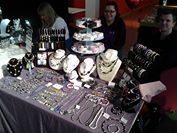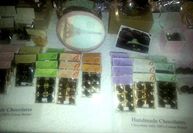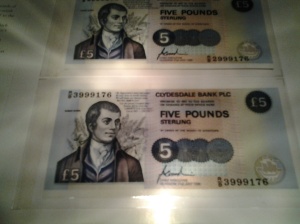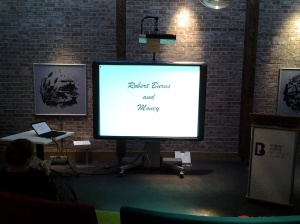Month: February 2014
Week of Luve!
The week before last, we at Robert Burns Birthplace Museum got into the romantic spirit by hosting a ‘Week of Luve’ in honour of Valentine’s Day. Our Bard is known to have written the occasional love poem, including those little known works ‘My Luve is like a Red, Red, Rose’ and ‘Ae Fond Kiss’, and we thought it would only be fitting to tap into the Valentine’s mood ourselves!
After a diligent Friday of decorating the museum foyer with heart shaped balloons and cards, the week began on Saturday 8th, with children’s craft activities at the museum. The opportunity to make pop-up Valentine’s Day cards and ‘Luve bugs’ with heartfelt messages inside appealed to many and we were soon running out of felt and sticky letters. Alongside this, our luve jewellery market was in full swing, and we set up several stalls of very colourful items for our visitors to browse through. On Sunday, our jewellery market was replaced by a chocolate one, and many treats and goodies were available for sale. We were also selling roses and other plants all weekend to round off the romantic feel.
Throughout the week, we held several luve themed talks and concerts in the lead up to Valentine’s Day. On Monday, we welcomed Linda Somerville to the museum, performing a selection of classical and Scottish luve songs, and on Thursday local Ayrshire singer Roger Paterson treated us all to a session of ‘Live Luve Music’ in the museum cafe. Our curator Rebecca held an in depth talk at the museum on Tuesday exploring Burns’s manuscripts and luve letters, and at our weekly Highlight Talk on Wednesday afternoon, our volunteer co-ordinator Alison Wilson gave a detailed discussion of one of Burns’s most romantic poems ‘My Luve is like a Red, Red, Rose’. All in all, by the time the big day arrived we were already feeling very luved up!
On the 14th itself, our wonderful volunteers held a ‘Red Red Rose’ plant sale at the museum selling plants, along with scrolls of Burns’s famous poem, which went like hot cakes throughout the day. No doubt all those last minute Valentine’s shoppers were out in force!
And that rounded our Week of Luve off nicely. We would like to say a massive thank you to all of our staff and volunteers who worked hard to make each event a success, and to you for joining in! We hope you enjoyed Valentine’s Day as much as we did!
Address to a Caterpillar Cake
In our family we usually mark birthdays by devouring a Chocolate caterpillar cake (Other insect-shaped desserts are available), and it’s great. It seemed appropriate to mark this sacrifice with a poem to salute the noble pudding, much as Robert Burns addressed his Haggis. This spin on ‘To a Mouse’ is the result:
Wee maukit chocolate-covered beastie,
O’whit a fondant’s in thy breastie,
Ye’ll mak an unco guid feastie,
Fer this birthday
I am sorry sic a hungry caterpillar,
A lettuce-champin cabbage-killer,
Should be a rumbling tummy-filler,
In sic a way
Ye are but swiss roll an smarties
But hame’s nae whit, but whaur the heart is,
An even the best laid birthday parties,
Gang aft agley
May ye hae smiles after ye’ve greetit,
An may ye always be well treatit,
An may ye hae yer cake an eat it,
Whiles cake ye hae
The curlers quat their roaring play…
You might have passed these stones at Burns Cottage and not even noticed them. One is under the bench at the garden entry door, one is in the Byre, and one is holding open the door between the Spence and Kitchen. These curling stones probably date from the mid-nineteenth century. They could be ‘sporting relics’ from when the cottage was run as an inn, but it is also not unusual to see old curling stones used as garden ornaments or as doorstops. Curling was once the most popular sport in lowland Scotland.
The earliest curling stones were simply riverbed boulders, with holes bored in the sides for finger and thumb. Later, iron handles were added. In Darvel, Ayrshire, it is recorded that the weavers would use the stone weights from their looms. Some stones would be hammer-dressed into a circular shape, with the lower surface polished to enable it to better slide along the ice.
Apparently the earliest written account of curling dates from the 1540s, when a Notary of Paisley relates that a monk at Paisley Abbey had challenged a colleague to a match of ‘quoits’ on the ice. Visual references to a game similar to curling can be found in the works of Pieter Bruegel the Elder, most noticeably in ‘The Hunters in the Snow’ (1565).
Fast-forward to the 18th century, and in John Sinclair’s The Statistical Account of Scotland (1791-1799) entry for Muirkirk, Ayrshire we find the following:
‘Their chief amusement in winter is curling, or playing stones on smooth ice; they eagerly vie with one another who shall come nearest the mark…’
Robert Burns mentions curling in two of his poems:
‘The sun had closed the winter day/The curlers quat their roaring play…’ (The Vision)
‘Roaring’ refers to the noise the granite stones make as they move along the ice. Curling is sometimes referred to as ‘The Roarin’ Game’.
‘When to the loughs the curlers flock,
Wi gleesome speed,
Wha will they station at the cock? —
Tam Samson’s dead!
He was the king o a’ the core,
To guard or draw or wick a bore,
Or up the rink like Jehu roar
In time o’ need;
But now he lags on death’s hog-score,
Tam Samson’s dead!’ (Tam Samson’s Elegy)
- The ‘cock’ was the term for the ‘tee’ where the curlers start from.
- To ‘guard’ is to place a stone in front of another to protect it from being knocked out
- A ‘draw’ is a shot that lands but does not hit another stone out
- To ‘wick a bore’ is to get a stone through an opening in previously placed stones
- The ‘hog-score’ is the line on the curling rink that stones must pass or be removed from the ice
Burns was not the only poet to celebrate curling. Allan Ramsay’s 1724 poem ‘To Robert Yarde of Devonshire’ begins thus:
‘Frae northern mountains clad with snaw,
where whistling winds incessant blaw,
in time now when the curling-stane
Slides murm’ring o’er the icy plain […]’
The Ayr and Alloway Curling Club was established in 1854. The curling pond was situated in the Rozelle Estate, in between the current duck-ponds and the Slaphouse Burn in neighbouring Belleisle. The sides of the pond can still be found in the woods.
In 1934, the Burns Chronicle published a letter between two friends of Burns (John Syme and Alexander Cunninghame) that provide evidence for Burns having been a curler, or at the very least, participated in a match:
[John Symes; 5 January 1789] ‘I missed a match with [Burns] last Friday at Dumfries where he played a Bonespeel with the curlers there…’
There is a bench seat in the Burns Monument Gardens that bears a depiction of curling stones. This is a memorial to Allister Boyd, a young curler who died from a brain tumour in 2009. The Culzean stonemasonry apprentices designed and made this bench, creating the curling stone detail out of Ailsa granite.
Ailsa Craig has been used as a source of granite for curling stones since the mid 19th century. The two types of granite found there are Green Ailsa granite and Blue Hone granite. Although blasting is no longer permitted, there is still plenty of loose granite to be used. The train track used to transport the stone to the small jetty is still visible underneath the grass, and much of the equipment is simply left to the mercy of the elements. The last ‘harvest’ of granite took place in 2013 by Kays of Scotland, who now have exclusive access to Ailsa granite.
(Rebecca Stapley, Curator)
Burns and Money
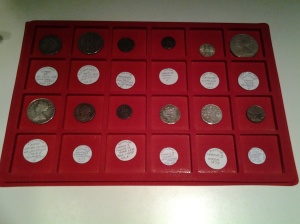
During Robert Burns’s life he would spend money, like everyone else, but in his early days he would not have very much to spend. He would probably not handle banknotes until about the time that his Edinburgh Edition of poems was published in 1787.
At the time of Burns the denominations of the coins used were quite different to those we use today. Twelve pennies were equal to one shilling and twenty shillings were equal to one pound. There were eight halfcrowns in a pound and twenty one shillings were known as a guinea.
The Union between Scotland and England had taken place in 1707 and before this date Scotland had its own coinage with the names for smaller denominations being “bawbees” which were sixpennies, “placks” which were fourpennies and “bodles” which were two pennies.
These denominations were Scots and the rate of exchange between Scotland and England required twelve pounds Scots to equal one pound English. The bawbee or sixpence Scots, at the time of Union was only equivalent to one halfpenny Sterling.
Although Robert Burns would never use these Scottish coins the names of the denominations continued to be used by the public and Burns used them to describe money in many of his poems.
In “O`er The Water To Charlie” he says “I’ll gie John Ross anither bawbee” as “bawbee” was by Burns time the name that was given to a halfpenny Sterling.
A farthing or quarter of a penny had become known as a “plack” and in many of his poems, epistles, songs and stories he mentions placks such as in “Scotch Drink” and in “Epistle to J. Lapraik”.
Another name given to the farthing was a “bodle” from the old Scots twopenny and he mentions a “bodle” in “Tam O’ Shanter” but he spells it with two “ds” instead of the old Scots of one “d”.
Robert Burns referred to many other coins such as the “groat” which was the Sterling fourpence and the “merk” which he spelt as “mark”. A merk was two thirds of a pound (or a 13/4d piece). In “To Collector Mitchell” he states “That one-pound-one, I sairly want it”. He was, of course, referring to a guinea which was one pound, one shilling or twenty one shillings.
I have written mainly of the small denomination coins that were used and quoted by Burns.
In 1786 we know that he was given ten guineas from a friend, Patrick Miller, and we are quite sure that they were Bank of Scotland one guinea notes.
1786 was the time when Robert Burns was thinking of emigrating to Jamaica to escape the problems in farming and, of course the father of Jean Armour, who Rabbie had made pregnant.
At this time he had written on the back of a Bank of Scotland one guinea note a verse :-
“Wae worth thy power, Thou cursed leaf!
Fell Source o’ a’ my woe and grief
For lack o’ thee I’ve lost my lass
For lack o’ thee I scrimp my glass
For lack o’ thee I leave this much-loved shore
Never, perhaps, to greet old Scotland more”.
That guinea note may still be seen at the Robert Burns Birthplace Museum in Alloway.
In recent times the Clydesdale Bank issued a £5 note in 1971 depicting a portrait of Robert Burns. It was based on the famous painting of him by Alexander Nasmyth and in 1996 on the anniversary of his death four different varieties of the note were issued with words from four of his poems.
In 2009 the Royal Mint struck £2 coins to commemorate the 250th Anniversary of the birth of the bard and in the same year the Clydesdale Bank promoted Rabbie to the £10 note and two years before the Bank of Scotland introduced the picture on the reverse of their £5 notes of the statue of Burns and the Brig O’Doon.
It will be interesting to see what the future will bring in relation to the commemoration of Robert Burns on money.
This post was written by one of RBBM’s Volunteers Ronnie Breingan, who gave a Highlight Talk on the subject earlier this year.

